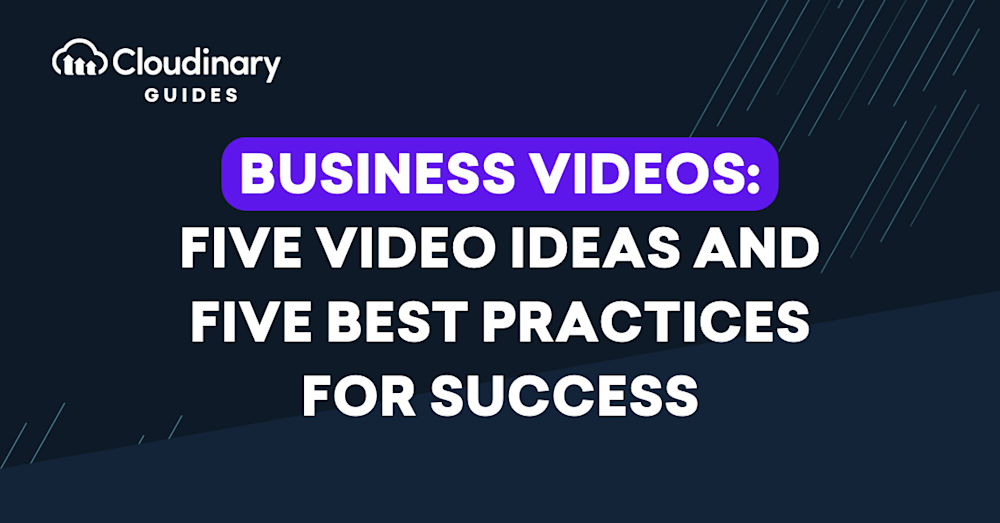What are Business Videos?
Business videos help organizations achieve a predefined objective, such as marketing, creation of awareness for products or services, and user or employee training. Effective business videos must have a strong concept and script for a specific target audience. The message must be simple and clear; the video, as short as possible. A call to action (CTA) is a must for marketing videos.
The common types of business videos are explainer videos, promotional videos, case studies and testimonials, training videos, and live-streaming videos, all slated to achieve business goals and offer value to key audiences.
This article covers the following topics:
- Five Ideas for Leveraging Videos in Your Business
- Best Practices for Creating Business Videos
- Automation of Management of Business Videos With Cloudinary
Five Ideas for Leveraging Videos in Your Business
Below is a description of the five types of business videos.
Explainer Videos
Explainer videos, which show how a product or service works, are targeted for the audience that’s aware of your offering and curious about how it works. Or, they’re already using your product or service and desire more information.
To be effective, explainer videos must be short, preferably 2-5 minutes long, focusing on the essential things users must know before using the product. Do not explain all the features or delve into technical details in explainer videos. High production quality is important for a positive brand image and continual engagement with viewers.
To evaluate the effectiveness of an explainer video, find out how viewers interact with it. Also, look for the sections the viewers watch more than once to determine if those sections are confusing or if a specific item is too complex, so much so that it warrants its own explainer video.
Related content: Product Videos 101: What Makes Them Great
Promotional Videos
Promotional videos, which attract consumer interest in your product or service, or announce new products and features to existing customers, are suitable for an audience that is highly relevant but not yet aware of your offer. This type of video, whose appropriate length is between 1-3 minutes, captures viewer attention through effective storytelling of captivating information. During the creation process, be sure to establish credibility and build trust with data or social proof.
To evaluate the effectiveness of a promotional video, find out from the play rates how many viewers of a webpage have played it and how long they watched it before dropping off. If the video features a call to action (CTA), click it; conversion rates is a critical metric.
For more details, see 12 Types of Marketing Videos and 10 Ways to Make Them Great.
Case Studies and Testimonials
Videos of case studies and testimonials show a real customer sharing his or her experience with your product, hence suitable for those who are aware of your offer but not yet convinced of its value, benefits, or quality.
To be effective, case-study videos should be between 5-30 minutes in length. At the outset, interview the customer and convert his or her story into a script that captures the facts and that also zeros in on the most important points, keeping your marketing goals in mind. Also, bring to light the personality of the customer being interviewed, describe that individual’s problem, and explain the way in which the product solved it.
To make the process easier, shoot the video on the customer’s premises.
To evaluate if your case-study video works well, check its play rate and play duration. Find the point at which the average viewer drops off and present the most relevant information until that point.
Training Videos
Videos can be very effective in delivering complex information—much more so than documents like user manuals. Training videos explain in depth a process, procedure, or concept that your customers or internal team must understand.
To be useful, training videos must be well structured. The instructor must be attractive, personable, well versed in the subject matter, and capable of explaining it clearly. Even though production quality is less important in training videos, their audio quality must be high and the visuals sharp.
Training videos can be anywhere between a few minutes and several hours in length.
To evaluate if a training video is effective, talk to the employees or users who have watched it. Ask them for a critique and, if possible, assess their knowledge level with a test or quiz.
Live-Streaming Videos
Live videos, an attraction for viewers, can generate special interest in your product or message. You can broadcast live to a social-media audience on many platforms, including YouTube, Facebook Live, Instagram, and Twitter. Research shows that viewers spend up to eight times more time watching live video streams than on-demand video.
To ensure a live video is effective, the live event, topic, and speakers must be attractive to viewers. In many cases, the title of the event can make or break participation rates. To ensure a successful live event, erect a professional camera setup and install suitable lighting. Give the speakers a top-notch headset or a broadcast-quality microphone.
To evaluate the success of your live stream, check how many people participated in the event and what percentage of them engaged with it by liking, commenting, or sharing the video. As with the other types of videos, the average view duration is an important metric.
For more details, see A Guide on Live Streaming and Tips for Making It a Success.
Best Practices for Creating Business Videos
Here are several important best practices for creating business videos.
Know Your Target Audience
Before starting on your script or filming, identify the target audience vis-a-vis your organization’s objectives and determine what that audience needs. If you aim to promote brand awareness, the audience in question is much larger and more heterogeneous than that for a training video on a specific feature of your product.
Create a Concept, Script, and Storyboard
The concept and script for your video determine its success. Start with pinpointing the video format: Will it be an animated video, a “talking heads” piece filmed in a studio, or a live-action production? Decide whether the script should be creative or strictly informative.
Next, develop an outline and add the details of your script. Finally, create an in-depth storyboard for your video.
Craft a Clear, Simple Message
Keep your message brief and omit corporate jargon and messaging unless it is relevant for the audience. The most effective videos are simple and easy to understand.
Whether you are producing a video for prospective or existing customers, if it’s too complex and detailed, viewers will leave and look for something more straightforward. So, mount an effort to make your video brief, compelling, and focused on a clear message.
To that end, carefully read through the script, edit out any redundant or unclear wording, and reduce the length to the minimum needed. Ensure that every sentence delivers important information and that the content is crystal-clear.
Keep It Brief
Studies show that a majority of video viewers stop watching after only one minute. So, keep the narrative of your business to the minimal length that’s appropriate for your format and audience. Even after you’ve wrapped up the video, edit it again to see if you can still shorten it. Repeat that process a few times.
Concise videos retain audience attention and entice those folks to carry out your CTA. While editing, always focus on delivering the essential information to fulfill your business or marketing goals.
Add a Call to Action
Like all marketing channels, marketing videos must have a direct, clear CTA. If your video aims at achieving a marketing or sales objective, use the CTA to move an engaged audience to the next point in your sales funnel. The CTA can be soft, such as an invitation for viewers to subscribe to a newsletter; or hard, such as a promotion of a specific sale. Pick the one that’s the most appropriate for the audience.
Always feature your CTA at the end and ensure that it steers viewers to your website, phone, or social media. Also, add an easy way for viewers to reach you and learn more about your organization even if they don’t take the CTA.
Automation of Management of Business Videos With Cloudinary
Business videos are an essential part of business strategies, especially in today’s highly competitive digital economy. However, creating, editing, distributing, and managing product videos can be expensive and time consuming. Cloudinary’s automation and management features save time, energy, and money. For example, you can leverage Cloudinary to quickly create product galleries, add branded content with transformation URLs, as well as deliver and manage product videos.
Give it a try! Start with creating a free Cloudinary account.


